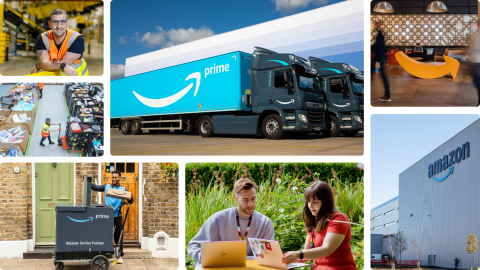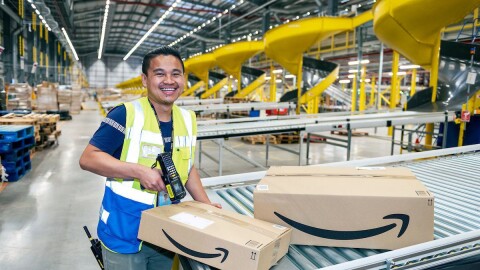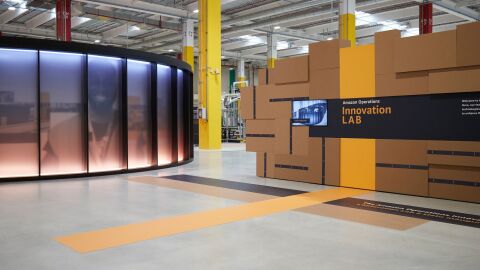Amazon Leo (formerly Project Kuiper) is Amazon’s low Earth orbit satellite network, designed to deliver fast, reliable internet connectivity to customers and communities beyond the reach of existing networks. To achieve this goal, Amazon is deploying thousands of satellites linked to a global network of antennas, fibre, and internet connection points on the ground.
Here we answer 15 common questions about Amazon Leo and the technology behind it.
1. Who will Amazon Leo help connect?

There are billions of people on the planet who lack high-speed internet access, and millions of businesses, governments, and other organisations operating in places without reliable connectivity. Poor connectivity means limited access to modern communications, education, health services, and other important resources, which can create an economic disadvantage for unserved and underserved communities.
We started Amazon Leo to deliver fast, reliable internet to customers and communities beyond the reach of existing networks, and we plan to deploy service to most countries around the globe, including hard-to-reach locations.
3. Why is it called Amazon Leo?
Amazon Leo is a reference to the low Earth orbit satellite constellation that powers our network. We started work under the code name “Project Kuiper,” but retired that name on 13 November 2025 and adopted Amazon Leo as our permanent identity.
4. Why is Amazon doing this?

You don’t have to travel far from major cities to lose internet connectivity—it can happen within a 60-minute drive from Amazon’s headquarters in Seattle. Cost, complexity, and geography can make it difficult to install traditional, ground-based fibre and wireless connectivity solutions in these areas.
Satellite broadband can fill many of those coverage gaps but developing and deploying satellite technology requires significant innovation and investment. Amazon has the people and resources required to deploy and operate global satellite broadband services, and we feel a responsibility to use our success and scale to help bridge the digital divide.
5. Is Amazon Leo part of Blue Origin?
No. Amazon Leo is an Amazon business, part of the same Devices and Services division responsible for Kindle, Echo, Fire TV, eero, Ring, and other tech devices. Blue Origin is a separate company founded by Jeff Bezos.
6. Where is Amazon Leo based?
Amazon Leo is headquartered in Redmond, Washington, where we conduct primary research and development. Our satellite production facility in Kirkland, Washington, gives us manufacturing capacity to build up to five satellites per day. Additionally, our satellite processing facility at Kennedy Space Centre, Florida, is where we prepare and integrate our satellites with rockets from Blue Origin, SpaceX, and United Launch Alliance ahead of launches.
7. How does Amazon Leo work?

Amazon Leo has three main parts: ground infrastructure, satellites, and customer terminals. Amazon’s ground infrastructure includes gateway antennas that securely send and receive customer data to and from satellites, along with telemetry, tracking, and control (TT&C) antennas that keep the satellites properly operating. Global networking connects those gateway antennas to the internet, public cloud, or private networks.
Our satellites make up the second part of the project. They operate in low Earth orbit and relay data traffic to and from our gateway antennas and customers. Lastly, customer terminals are the technology that Amazon Leo customers use to receive internet service. Our terminals combine antennas and processors into a single, compact system to deliver connectivity.
8. How many satellites will Amazon Leo have?
Amazon Leo’s initial satellite constellation design includes more than 3,000 satellites. The term “constellation” refers to a group of similar satellites working together with tightly coordinated movements to achieve a common purpose—in this case, providing reliable broadband coverage.
9. What is low Earth orbit?
Low Earth orbit is an area of space that extends up to 2,000 kilometres (about 1,243 miles) above Earth. Amazon Leo satellites will orbit between 590 and 630 kilometres (about 367 and 392 miles).
10. What are the benefits of low Earth orbit satellite internet?
Satellite internet works by sending signals to and from space to wherever the user is based on Earth, as long as the user has a clear view of the sky. This makes it possible to connect even in remote locations where traditional communications technologies don’t reach. Low Earth orbit satellite networks like Amazon Leo offer very broad coverage with even lower latency than traditional satellite internet because the satellites fly closer to Earth. That proximity makes Amazon Leo effective for uses like video calls, gaming, and high-definition streaming.
11. How do the satellites get into space?

We work with commercial launch providers to send Amazon Leo satellites into space. We’ve secured more than 80 launches from Arianespace, Blue Origin, SpaceX, and ULA to deploy our initial satellite constellation. Together, these agreements represent the largest commercial procurement of launch vehicles in history.
12. Is it safe to have so many satellites in space?
Space safety and sustainability are core tenets of Amazon Leo and have been from the beginning. Those tenets have influenced everything from the overall architecture of our satellite system to the design of the satellites themselves and the way we engage external stakeholders like scientists and other space operators.
13. How fast will Amazon Leo internet be?

Amazon Leo technology provides fast, reliable connectivity to address diverse needs, and we will offer our customers a range of options. Our standard customer terminal delivers downlink speeds up to 400 megabits per second (Mbps); our largest model, which is intended for enterprise, government, and telecommunications applications, delivers up to 1 gigabit per second (Gbps); and our ultra-compact model delivers up to 100 Mbps.
14. When will Amazon Leo service be available in the UK?
In February 2025, Amazon Leo received approval from the UK communications regulator Ofcom to offer satellite internet in the UK. Our focus is delivering the best possible and reliable broadband service to meet the needs of customers in the UK, which will be among the first countries to receive general Amazon Leo services. We expect to introduce Amazon Leo service to select enterprise customers by the end of 2025 and will roll out service more widely in 2026 as we launch more satellites and add coverage and capacity to the network.
15. Can I sign up for a waitlist?
If you’re interested in staying informed about Amazon Leo, you can visit our website and sign up for our newsletter.
Learn more about Amazon Leo.
Find out more about the latest news at Amazon.












